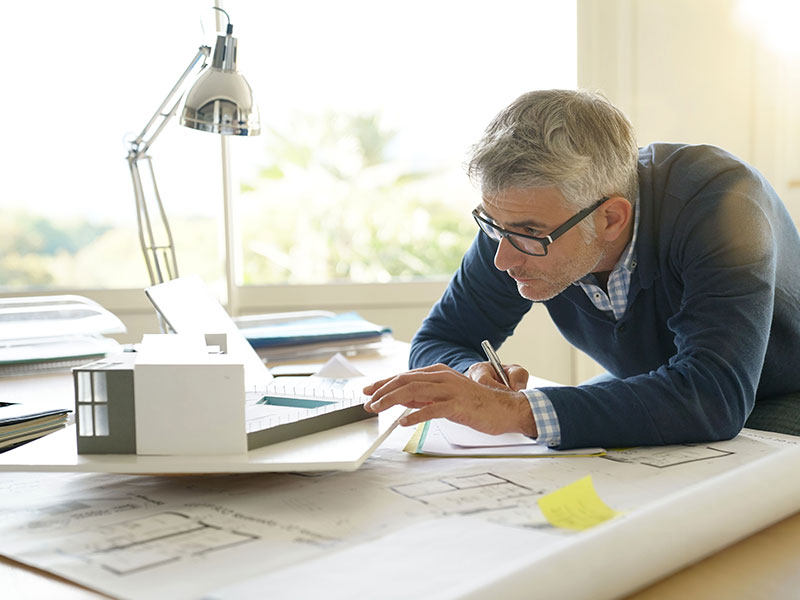Architect Career Path: Abilities, Training, and Advancement Guide
Architect Career Path: Abilities, Training, and Advancement Guide
Blog Article
Recognizing the Diverse Career Paths Available for Aspiring Architect
As an aspiring Architect, you have a world of career paths waiting for you. Whether you're drawn to traditional architecture or the subtleties of lasting design, there's a specific niche that straightens with your interests.
Traditional Architecture: Creating Structures and buildings
Conventional architecture focuses on making buildings and structures that mix performance with visual charm. Your styles can show social heritage, showcasing regional customs while satisfying modern-day needs.
You'll create abilities in composing, model-making, and website evaluation, allowing you to envision and communicate your concepts efficiently. Involving with customers, you'll require to recognize their vision and convert it right into practical designs.
In addition, developing codes and sustainability techniques are important in your job, ensuring your structures are secure and ecologically pleasant. As you grow in your career, you'll find possibilities in domestic, business, and even remediation jobs, each offering special difficulties. Accepting conventional style leads the way for a meeting job that pays homage to the past while shaping the future.
Urban Planning: Shaping Neighborhoods and Public Spaces
As a hopeful Architect, you can play a necessary function as an urban coordinator, transforming how areas communicate and work. By employing neighborhood interaction approaches, you'll assure that homeowners have a voice in shaping their setting. And also, incorporating sustainable layout principles will certainly aid produce rooms that not only fulfill today's demands yet likewise safeguard the future.
Function of Urban Planners
While many may assume of engineers as the sole enthusiasts behind buildings, urban planners play a vital function in forming the broader landscape of areas and public spaces. By teaming up with numerous stakeholders, you'll help design parks, transportation systems, and domestic areas that advertise social communication and accessibility. Your knowledge in spatial layout and community characteristics allows you to imagine future development while maintaining cultural heritage.
Neighborhood Involvement Approaches
Reliable community interaction techniques are important for city organizers to guarantee that the voices of citizens are heard and valued in the preparation process. To promote purposeful discussion, you must prioritize open forums and workshops where community participants can share their ideas and issues. By proactively listening and incorporating feedback, you'll develop areas that mirror the neighborhood's requirements, inevitably leading to more sustainable and effective city settings.
Lasting Style Principles
When making urban rooms, including lasting design concepts is essential for developing environments that prosper both ecologically and socially. Consider incorporating environment-friendly rooms, like parks and gardens, to enhance biodiversity and boost air top quality.
Designing with water preservation in mind is likewise key-- consider rain gardens and permeable surface areas to manage stormwater. Entailing community members throughout the planning procedure warranties that the rooms you create satisfy their demands and motivate social communication. By embracing these principles, you'll add to vivid, lasting metropolitan landscapes that benefit everyone.

Landscape Design: Producing Sustainable Exterior Atmospheres
As you explore landscape design, you'll discover crucial design principles that develop useful and stunning exterior rooms. Sustainable methods play an essential duty in ensuring these settings grow while reducing environmental effect. Plus, you'll locate a selection of profession chances that allow you to make an actual distinction in just how individuals connect with nature.
Layout Principles in Landscape
Comprehending style concepts in landscape design is crucial for creating sustainable outdoor settings that integrate with nature. You'll require to consider elements like percentage, equilibrium, and range to assure your designs really feel natural and inviting. Integrating indigenous plants not just enhances biodiversity but likewise lowers water use, making your landscape durable. Think concerning the flow of area and just how individuals connect with it; paths and seating areas ought to invite exploration and leisure. In addition, focus on seasonal adjustments, making with products that enhance the surroundings year-round (Architect). By prioritizing sustainability and appearances, you can develop exterior spaces that improve the neighborhood and promote well-being. Accepting these principles will certainly establish a strong foundation for your career in landscape architecture.
Sustainable Practices Overview
Lasting practices in landscape style not just focus on aesthetic appeals however additionally prioritize eco-friendly wellness and source conservation. You can design rooms that advertise dirt health, such as making use of organic products and exercising permaculture principles. Inevitably, these techniques ensure your layouts benefit both people and the environment for years to come.
Job Opportunities Expedition
With a solid structure in sustainable practices, landscape style uses a range of career courses that enable you to make a significant impact on the setting. Urban coordinators frequently collaborate with landscape engineers to produce green rooms in metropolitan setups, improving city livability. If you're enthusiastic concerning education, take into consideration ending up being a landscape architecture teacher, inspiring future generations.
Lasting Design: Concentrating on Eco-Friendly Practices
As you explore your job in architecture, accepting environment-friendly practices can establish you apart in an affordable area. Sustainable layout concentrates on producing structures that reduce environmental impact while improving owner well-being. By including sustainable products, energy-efficient systems, and sustainable building strategies, you'll add to a greener future.
Begin by obtaining understanding of environment-friendly accreditations like LEED or BREEAM, which can strengthen your credentials. Think about exactly how all-natural light, ventilation, and thermal performance can optimize style. Team up with engineers and ecological professionals to innovate services that minimize waste and preserve resources.
Don't fail to remember go to my blog the relevance of community involvement-- engaging regional stakeholders can motivate layouts that balance with the atmosphere. As clients progressively focus on sustainability, your competence in green practices will not only bring in jobs yet additionally fulfill your passion for accountable architecture. Embrace this important element of the occupation, and watch your profession thrive.
Historic Preservation: Safeguarding and Restoring Social Heritage
While you start on your building trip, think about the vital function of historic preservation in preserving our cultural heritage. This area concentrates on the security and repair of substantial buildings, sites, and frameworks that inform the stories of our past. By taking part in historic preservation, you'll assist secure the building heritage that forms community identity.
As a historic preservation Architect, you'll evaluate historical relevance and evaluate the condition of frameworks. You'll work very closely with historians and guardians to ensure authentic reconstruction techniques are used. This profession course enables you to mix imagination with research, allowing you to develop remedies that appreciate initial materials and workmanship.
Your work not just adds to sustainability by reusing existing structures but likewise fosters a feeling of pride within areas. Embracing this course will aid you become a guardian of history, maintaining the stories and visual appeals that improve our lives.
Interior Design: Enhancing Indoor Spaces
Historical preservation and interior design both share a dedication to enhancing the developed setting, but they concentrate on various facets. While historic preservation stresses keeping a structure's cultural and historical worth, interior design nos in on optimizing indoor areas for capability and aesthetic appeals.
As an ambitious Architect, you'll find that interior design enables you to mix creative thinking with technical skills. You'll create rooms that not just look excellent yet additionally advertise convenience and performance. This area entails understanding how light, shade, and products engage within an area, impacting mood and use.
You'll deal with different tasks, from residential homes to commercial offices, making certain that each environment meets the needs of its owners. By prioritizing user experience, you can transform insides right into inspiring and useful areas, making a substantial influence on exactly how people communicate with their surroundings. Embrace the opportunity to enhance interior atmospheres and form the way people function and live.
Industrial Layout: Merging Functionality With Appearances
Commercial style plays a necessary function in creating items that effortlessly mix aesthetic appeals with functionality, ensuring that what you make use of everyday is not just aesthetically attractive but additionally useful. As an aspiring Architect, you can engage on your own in this field, focusing on creating everything from furniture to customer electronics. Your job involves recognizing user requirements, materials, and producing procedures, allowing you to produce ingenious services that boost daily experiences.
In industrial style, you'll commonly team up with manufacturers, designers, and marketers, ensuring that your designs are not only attractive yet additionally feasible. This profession path provides a dynamic environment where creativity fulfills functionality, making it a satisfying selection for engineers interested in forming the products of tomorrow.
Regularly Asked Inquiries
What Educational Accreditations Do I Required to End Up Being an Architect?
To come to be a designer, you'll need a professional level in design, normally a Bachelor's or Master's. Furthermore, you'll need to complete an internship and pass the Architect Registration Exam to practice legally.
Exist Certification Needs for Different Building Career Paths?
Yes, there're qualification needs for different architectural courses. Architect. You'll require to pass tests, full internships, and sometimes pursue specialized training, depending upon your chosen emphasis, like landscape architecture, metropolitan design, or historical preservation
What Software Abilities Are Important for Architects Today?

Exactly How Can I Gain Practical Experience While Studying Style?
You can acquire sensible experience by interning at building firms, getting involved in design competitors, volunteering for area jobs, or working together with schoolmates on real-world projects. These opportunities improve your abilities and develop beneficial connections in the see sector.
What Work Opportunities Exist Outdoors Traditional Design Firms?
You can explore various job possibilities outside traditional design companies, like metropolitan preparation, interior decoration, landscape style, building administration, genuine estate growth, or perhaps functions Get More Info in sustainability consulting. Each deals unique difficulties and incentives.
Whether you're drawn to typical architecture or the nuances of lasting layout, there's a specific niche that straightens with your rate of interests.When making urban areas, including lasting design principles is critical for creating atmospheres that prosper both environmentally and socially.As you explore landscape architecture, you'll find necessary style concepts that develop beautiful and practical outside areas.Comprehending layout concepts in landscape style is crucial for developing sustainable exterior environments that balance with nature.In industrial design, you'll often work together with engineers, marketing experts, and manufacturers, making sure that your styles are not only beautiful yet additionally viable.
Report this page